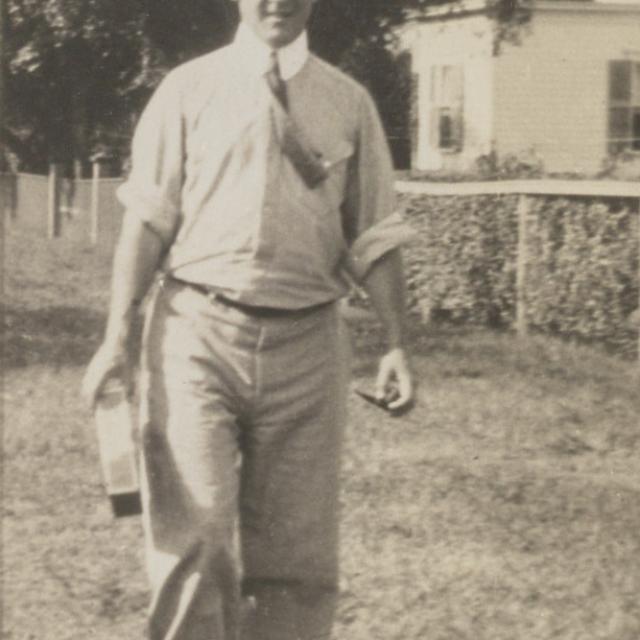
William Glackens
Glackens, William James
American, 1870 - 1938
William James Glackens was born in Philadelphia on March 13, 1870, to Elizabeth Finn Glackens and Samuel Glackens, a clerk for the Pennsylvania Railroad. Both William and his older brother, Louis (American, 1866–1933), who would later become an illustrator, showed an early talent for drawing. Glackens attended Central High School, known for its strong art program. His classmates there included John Sloan (American, 1871–1951) and Albert C. Barnes. After graduation in 1890, Glackens worked as a newspaper illustrator, first for the Philadelphia Record and a year later for the Philadelphia Press, which also employed Sloan, George Luks (American, 1867–1933), and Everett Shinn (American, 1876–1953). From 1891 to 1894, Glackens took classes at the Pennsylvania Academy of the Fine Arts, where he studied under Thomas Anshutz (American, 1851–1912).
In 1892 Glackens met Robert Henri (American, 1865–1929), who became a teacher and role model for the artists in Glackens’s circle. Henri and Glackens shared a studio before setting sail for Europe in 1895 with a group of Philadelphia peers, including Sloan. They visited Belgium and Holland, where Glackens was deeply impressed by the works of Frans Hals (Dutch, c. 1581–1666) and Rembrandt van Rijn (Dutch, 1606–1669). Glackens then spent a year in Paris, returning to the United States in 1896. He settled in New York and briefly shared a studio with Luks. A brilliant draftsman, Glackens became a highly successful illustrator and contributed to a number of periodicals, including New York World and McClure’s Magazine, which sent him to Cuba to cover the Spanish-American War. He later worked for Scribner’s and the Saturday Evening Post.
Glackens aspired to pursue a career in fine art and continued to paint. In 1901 he began to exhibit in group shows organized by Henri. In the same year, he met Edith Dimock, a fellow artist who had studied at the Art Students League. Glackens’s 1904 marriage to Dimock, the daughter of a wealthy Hartford, Connecticut, silk manufacturer, gave him a measure of financial security. The couple would have two children, Ira and Lenna. After Glackens painted his celebrated Chez Mouquin (1905, Art Institute of Chicago), he and Dimock went to Spain and France on a delayed honeymoon in 1906. In Spain Glackens was drawn to the work of Diego Velázquez (Spanish, 1599–1660) and Francisco de Goya (Spanish, 1746–1828).
The turning point in Glackens’s career occurred in 1908, when he participated in an exhibition at New York’s Macbeth Gallery with the American painters who became known as The Eight. These artists, along with George Bellows (American, 1882–1925) and several others, were later dubbed the Ashcan school for their focus on the grittier side of modern New York. Glackens, who in his work as an illustrator depicted a cross section of urban life, largely portrayed those of his own social class in his paintings.
In the years following the exhibition of The Eight, Glackens moved away from urban subject matter and dark tonalities. He began to paint vibrant, impressionist landscapes, marine scenes, portraits, and still-life subjects in a bright, sensuous palette that drew comparisons to Auguste Renoir (French, 1841–1919). Glackens played significant roles in organizing the Exhibition of Independent Artists in 1910 and the Armory Show in 1913. He reconnected with his former classmate Albert Barnes, who sent Glackens and Alfred Maurer (American, 1868–1932) to Paris in 1912 to purchase modern paintings that would form the basis of the Barnes Foundation collection in Philadelphia. This exposure to innovative French paintings reinforced Glackens’s new stylistic interests. That same year, Glackens had his first solo exhibition at the Madison Art Gallery in New York. He was elected an academician of the National Academy of Design in 1933. Glackens died in Westport, Connecticut, on May 22, 1938.
Explore Selected Works
Artwork

Invitation: New Society of Artists Dinner
Invitation: New Society of Artists Dinner
William Glackens · 1924 · lithograph · Accession ID 2008.115.2125
Artwork

I Went Down that There Slide Faster than the Empire State Express
I Went Down that There Slide Faster than the Empire State Express
William Glackens · 1910-1913 · conté crayon with gouache on wove paper · Accession ID 2015.19.531
Artwork

Artwork

Coney Island Boardwalk
Coney Island Boardwalk
William Glackens · c. 1907-1909 · pen and black ink on wove paper · Accession ID 2015.143.1353
Artwork

Luxembourg Gardens
Luxembourg Gardens
William Glackens · 1906 · oil on canvas · Accession ID 2014.79.47
Artwork

Reclining Female Nude
Reclining Female Nude
William Glackens · c. 1910 · chalk and pastel on gray wove paper · Accession ID 2015.143.76
Artwork

Studies of Women by the Park Railing
Studies of Women by the Park Railing
William Glackens · c. 1905 · charcoal on wove paper · Accession ID 2015.19.574
Artwork

Papa, Carry Me—Take Me Up in Your Arms
Papa, Carry Me—Take Me Up in Your Arms
William Glackens · c. 1904 · graphite, brush and black ink, and charcoal on wove paper · Accession ID 2015.143.56
Bibliography
1957
Glackens, Ira. William Glackens and the Ashcan Group: the Emergence of Realism in American Art. New York, 1957.
1996
Gerdts, William H. William Glackens. Fort Lauderdale, FL, and New York, 1996.


